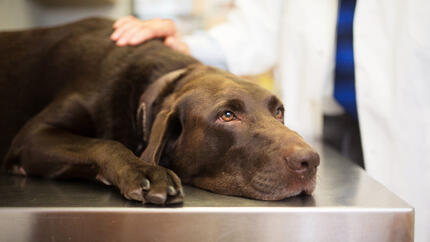
From digestive problems in dogs to coughing, our pets can sometimes be subjected to health issues that need treatment – especially our dogs who can often be prone to getting into trouble when they explore outside. From being stung by bees, to being a little too curious with stinging nettles, they can give themselves allergic reactions. As Benadryl helps us humans with our allergies so well, you might be wondering ‘can I give Benadryl to my dog?’ Find out if you can and if so, how much is safe for them to take.
What is Benadryl?
Diphenhydramine, more commonly known to us as Benadryl, is an antihistamine which relieves the symptoms of allergies. For us humans, it’s a great antihistamine, and for our dogs, it can be great too (in the correct dosage). Vets use Diphenhydramine to treat allergies and allergic reactions to insect bites/stings. It works by blocking the H-1 receptors on smooth muscle and blood vessels.
What does Benadryl treat in dogs?
Benadryl for dogs can be good for treating mild dog allergies and things like motion sickness when travelling with your dog. It’s important to make sure this is given with your vet’s advice and in the correct dosage (more on this later).
Benadryl for dog allergies
For dogs who have might have stuck their nose where they shouldn’t have, Benadryl can be used as an antihistamine. If they’ve been bitten or stung by an insect, it can be moderately effective for mild allergic reactions in dogs.
In some cases, Benadryl for dogs can be used for pre-treatment when your dog is given a vaccine. Always check this with your vet first.
Benadryl for dog travel and anxiety
When travelling with your pup, it’s possible that they could get motion sick. For long distances, the right dosage of Benadryl can help with this and be safe.
Some dogs get scared during thunderstorms or when fireworks are out to play. Benadryl (in the correct dosage) can act as a mild sedative. Though, this does depend on your dog, as some can actually have the opposite reaction. There are other medications however that can be more helpful so consult with your vet rather than self-medicating your dog.
How can I tell if my dog is having an allergic reaction?
Benadryl for dogs can be beneficial but what are the signs your dog may need medication if they’re experiencing allergies?
Here are some common symptoms:
Itchy skin
Recurring ear infections
(Clear) runny nose
Red and swollen eyes
Sneezing fits
If you see any of these symptoms in your dog, talk to your vet about the best medication.
Can I give Benadryl to my dog?
You might be wondering ‘How much Benadryl can I give to my dog?’ Well, the amount depends on the size and weight of your dog. Each dog is unique and can react differently. Always ask your vet before you administer any Benadryl treatment.
It’s highly important to get the dosage correct as most Benadryl tablets are meant for human consumption. Because of their size, the dosage of Benadryl for dogs is different to that of humans. Dogs metabolise it differently, so it’s imperative to work out the right dosage in conjunction with your vet.
It’s important to note: Benadryl should not be given to dogs with some health conditions. Similarly, Benadryl can also react with some other medications that your dog might be taking. For both these reasons, it’s again imperative to consult your vet first.
Benadryl Dosage for Dogs
As we said, the correct dosage depends on your dog’s weight. The Merck Veterinary Manual suggests that the safe dosage is 2-4 milligrams of medication per kilogram of weight. This amount can be administered two to three times daily, depending on your dog’s symptoms. There may however be other reasons to adjust this dosage (or avoid Benadryl totally) and so always work in conjunction with your vet.
Some things to note about Benadryl for dogs:
Smaller dogs might do better with children’s Benadryl (consult your vet first).
If you find a generic version of Benadryl, it MUST be only diphenhydramine – no other active ingredients.
Never give your dog time-related capsules – there’s a risk of overdose.
Ask your vet before giving the liquid version of Benadryl – these work slightly differently.
Side effects of Benadryl in Dogs
Though we’ve answered the questions ‘can I give my dogs Benadryl?’ and ‘how much Benadryl can I give my dog?’, it’s important to keep in mind that there can be (not so dangerous) side effects.
Increased heart rate
Sleepiness
A dry mouth
Fast breathing
Hypersalivation
If your dog experiences any of these, call your vet immediately.
Allergy to Benadryl for Dogs
More severely, your dog might have an allergy to diphenhydramine - here are some symptoms to look out for:
Swelling of face and tongue.
Vomiting, diarrhoea and an upset stomach.
Licking or chewing their skin.
Red rashes on skin.
If you see any of these symptoms, or any other unusual reactions, contact your vet immediately.
When to contact your vet
In an emergency, you should always call your vet immediately. Your dog might be experiencing anaphylactic shock, either from allergies or (as we mentioned) from Benadryl itself.
Call your vet (even if out of hours) if your dog is:
Vomiting
Experiencing diarrhoea
Swelling
Struggling to breathe
Experiencing seizures
Your dog may need immediate treatment. If you’re not sure what your dog has been bitten or stung by, it may be serious. To ensure your dog isn’t poisoned, call your vet immediately. The sooner you get help, the better!









